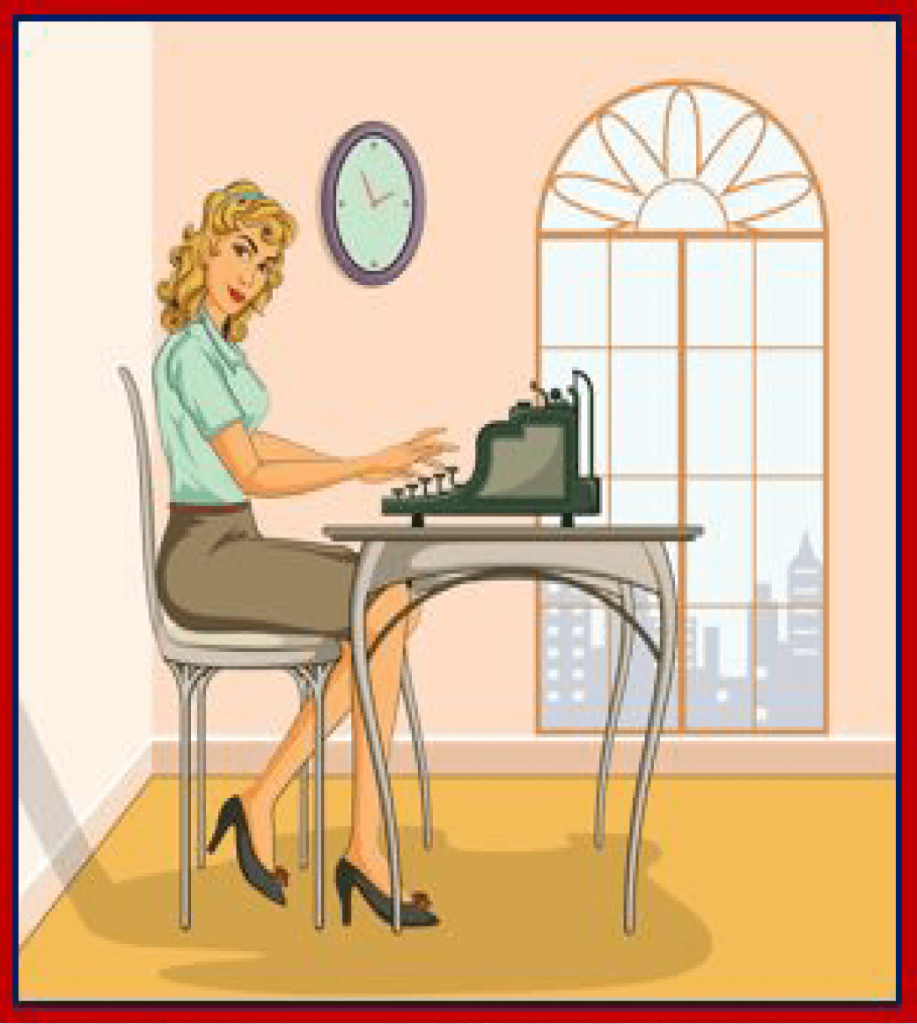

It’s about a Marvel Avenger called the Scarlet Witch (Wanda Maximoff) who grieves the loss of her husband, another superhero called Vision. As part of her healing process, Wanda takes over a suburban town and turns it into a TV Sitcom as her way to deal with the loss of her husband. Throughout the series Wanda plays different TV Sitcom Mom roles.
Watching Wandavision on Disney Plus got me thinking about a paper I wrote in college called Hunting for the Good 1950’s Suburban American Housewife in Myth, Literature and Television.
This paper shows the reality of a 1950s American housewife is vastly different than their lives portrayed in myth, literature and TV.
My writing voice and style has changed and evolved since I wrote this paper and everything I’ve written since. This is relevant because I just received the proofreader’s review of my latest manuscript The Devil Pulls the Strings and his comments:
“The story was very entertaining to read and edit, which probably helped me finish it sooner than I expected. I had a lot of fun with this one! I found the plot and the writing style pretty captivating. Boone’s character is funny, lighthearted, and easy to like. I think the book will especially appeal to a young audience. Its tone reminds me of the adventure/fantasy books I enjoyed as a kid. I also appreciated all the music references throughout the book. It was really nice to listen to while editing, and it was good to discover a few Paganini pieces I’d never heard before.” – F. Kelly
Getting an A or an A+ and some random comments from a professor on a paper written in college felt good, but not as good as my proofreader’s feedback affirms and validates all my efforts in ways no college paper or thesis I wrote ever did. Here’s to your own writing success, and may what you write today, springboard into bigger and better things after,
Joseph
P.S. Shown further down is a page is my paper.
By J. W. Zarek
“Any change in the nature of male and female roles thus automatically affects the home, the economy, the school, and perhaps above all, the definition of who we are as human beings.”
-William Chafe, A history of Our Time (2002)

The American suburban housewife in the 1950s became a dream image and envy of women all over the world because science and labor-saving appliance eliminated the drudgery of housework, the dangers of childbirth, and the illnesses of their grandmothers.
The 1950s American suburban housewife is healthy, educate, and beautiful. She’s focused on her husband, their children, home, and had found true feminine fulfillment as a housewife and mother. She’s respected as a full and equal partner to man in his world and free to choose automobiles, clothes, appliances, and supermarkets at which she shopped freely.
Why the American 1950s suburban housewife had everything women ever dreamed of (Friedan 1997) or so the myth went. And popular television series of the day Leave It to Beaver, Father Knows Best, and The Donna Reed Show contributed to and propagated the myth of the stereotype of the American Suburban housewife. (Snopes.com 1999)
Why the American 1950s suburban housewife had everything women ever dreamed of (Friedan 1997) or so the myth went. And popular television series of the day Leave It to Beaver, Father Knows Best, and The Donna Reed Show contributed to and propagated the myth of the stereotype of the American Suburban housewife. (Snopes.com 1999)
So while images of June Clever, Margaret Anderson, and Donna Stone may have exemplified the ideal 1950s suburban housewife and mother, how much did real women’s lives have in common with their sitcom counterparts (Millard 2008)?


For an in-depth understanding of what women experienced in the 1950s, one would have to examine many things: oral histories, memoirs, novels, magazine articles, advertisements, movies, TV programs, and works of history to form a more accurate picture of how things were for women back in the 1950’s (Busch 2009).
What were women’s actual experience regarding marriage, family life, the workplace, politics, and the many messages received about what constituted appropriate behavior in public and private life?
What major social and cultural trends were occurring at the time? And was women’s participation in these things contributing to change in American?
In the 1950’s America experienced a growth in suburbia, the rise of the consumer culture, the Cold War, the Civil Rights movement, as well as coming to grips with the new youth culture and their Beat Generation and rock and roll.
Adding to this was the rich diversity of women and their experience based on differences in race, ethnicity, class, religion, and age which contributed to the opportunities and choices available to women of the time.
Elizabeth Kaufer Busch does an excellent job sharing with her readers a brief history of the post-feminist heroine by extensively referencing Betty Friedan’s work originally written in 1957 on feminism mystique (Busch 2009). But David Horowitz reveals Betty Friedan is not what she claims to be (Horowitz 1999). So instead of relying on work that may be deemed fiction, one can instead examine available facts.


During World War II, millions of women were thrust into the workfare and encouraged to provide labor in industrial factories to help the war effort. Propaganda campaigns were used to convince women they should now work in the perceived “men’s jobs,” because the same skills they used in housework allowed them to work in factories. Place people in well-paying job, and a majority of them would not want to give them up. Such was the case after World War II and women. They did not want to give up their well-paying jobs. This troubled American leaders, business leaders, and veterans returning from the war.
To counter this resistance, the government created another propaganda program, this time to convince women they should be patriotic and give back jobs to their men. Ads of the time told women they would be much happier if they went back home and had children and gave men back their jobs. Women were told now that the war was over they should return to their more traditional roles as housewives and mothers. Women did not need these jobs, but men did.


From the late 1940s throughout the 195s, there was tremendous pressure on women to accept their more traditional roles as wives and mothers, dependent on their husbands, and committed to living their lives for their families, children, and husbands. In essence to become the suburban housewife of the 1950s.
So what happened in the fifteen years following World War II? This was not a time for reflection and analysis, rather a period of re-massing and struggle because millions of women attempted to live up to the imagine of the fantasy American Suburban housewife seen in photographs, advertising, and on TV. Kissing their husbands goodbye, dropping their kids off to school, smiling as they operated the latest home improvement appliance, baking bread, sewing, while their new washing machines and dryers ran. Sheets were changed twice a week, dance classes were taken, and pity felt for all of those poor frustrated mothers, who had dreamed of having a career.
How many of these women actually dreamed to be a perfect wife and mother, with their highest ambition being to have five children and a beautiful home? There were no thoughts for the unfeminine problems of the world. Let their husbands make all the major decisions.
Other myths of the day were if a woman had a problem, she knew that something must be wrong with her marriage or herself, because other women were satisfied with their lives. It was the common misconception.
And how many women thought less of themselves when they did not feel the mysterious fulfillment waxing the kitchen floor brings? The 1950s housewife may have been ashamed to admit any level of dissatisfaction. It did not help she never knew if there were other women out there experiencing something similar because such things were not openly discussed. Turning to the men in their lives did not help because they could not understand what the women were complaining about because they did not understand it.


Attempting to live up to this illusion of being the perfect 1950s American suburban house wife was actually a trap with a continual demand of a woman’s time. The major irony was this trap was based on mistaken ideas and misinterpreted facts many women could neither see nor shake off. It would be a long, hard road, but women would eventually shift from being continually relegated and segregated into second-class jobs and couldn’t break through the glass ceilings of many industries, and politics.
Despite how successful the campaign to convince women to return to their more traditional roles, millions of married women in the 1950s continued to work. What was going on that forced may white, middle-class women, married and with children, to enter the labor force in record numbers in the 1960? Especially when society was telling them to stay home and be traditional wife. Let their husbands support them. This was party because their families needed support.
Many middle-class married woman took jobs soon after their children started school and worked for eth rest of their lives. No matter how much greater their responsibilities and roles in the workforce grew, women were still responsible for doing all the traditional work as wives and mothers. Women worked because it allowed them to have their big homes, nice cars, send their kids to universities, and take long vacations.
What a struggle this must have been for these women. They were told to ignore the changes being experienced as a result of World War II. And their presence in the workforce, they still had to reconcile their traditional role with their expanding confidence and independence as working women. Is it no wonder such women would have a greater say in the finances, marriage and family life, while demanding more equality and respect from their husbands and families?


And while American women were being told that some might be working, their work was not important, and it should never get in the way of their duty and responsibilities as wives and mothers.
Thankfully it was through such individuals as Jessamyn Neuhaus, housewife turned writer, who was not satisfied with being just another housewife. She turned to writing as a form of retreat and escape from day-to-day drudgery (Neuhaus 2009). Neuhaus’ writing inspired many women to express and liberate themselves through their own writing.


Still, despite the growing trend in the workforce, some held onto the belief that nothing was changing and women were content to being relegated to the traditional roles of wife and mother. It is no wonder that the women’s movement and the Equal Rights movement (ERA) in the 1960s and the 1970s grew out of this increasing contradiction between the growing changes in women’s lives and society’s efforts to convince women these changes weren’t occurring in the 1950s.











Drop me a line, I would love to hear from you!
All images, text, materials, code displayed on this website are Copyright © by J.W. Zarek. Illustration created by Peter Johnston. All Rights Reserved.
Author Website design by Rocket Expansion – © 2021


Author of Non-fiction, Fantasy
and Graphic Novels